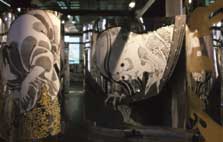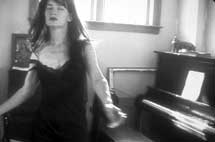The Moderns
- Castello di Rivoli Torino
- Museo d’Arte Contemporanea

| Arata Isozaki |


|

|
  |
||
| Janet Cardiff 1 | Evan Hollway | |||
The Moderns
Is a group show which which explores the ways in which a number of
artists are engaging with modernism and modernity round the world today.
This exhibition will include sculpture, installations, projections,
painting, drawing, and sound projects. It will present new and existing
works by over 20 artists, including Haluk Akakce, Ricci Albenda, Massimo
Bartolini, Ellsabetta Benassl, Taclta Dean, Tom Friedman, Liam Gihick,
Arturo Herrera, Evan Holloway, Brian Jungen, Jim Lambie, Dana Martin,
Julie Mehretu, Jun Nguyen-Hatsushlba, Jorge Pardo, Paul Pfeiffer, Susan
Phlllpsz, John Pilson, Simon Starling, Sarah Sze, Piotr Uklanskl and
Gary Webb.
"Today, a growing number of artists round the world are referring to modernism or using icons of modernity as narratives and fictions In their artworks. The digital world is Internationalist, as were the modernists; it aims to go beyond the local/global dichotomy, while at the same time achieving a reach broader than anything the modernists achieved. The digital mind is a project-based mind, encouraging a sense of ‘agency’, an ability to make choices and act, to have a point of view and a perspectival gaze, even within contemporary notions of multiplicity. Memory and Modernity are Intertwined (the ‘future’ Is a notion belonging to the past), and in some instances this Idea takes form in the use of the history of film as a medium and subject for cinema, after photography, has been the most outstanding innovative cultural practice In the Modern Age. In other instances, it is to the formalism of ‘high modernist’ art In painting and sculpture that artists are looking. For such artists, issues of form, color, composition and linguistic experimentation are topical. Science, absurd or useless science, as well as its fantastic variant science fiction, are also sources for many artists today, and are primary metaphors being used." (Carolyn Christov Bakarglev) The exhibition will also include a sound section selected and organized by Anthony Huberman, including works by Kim Cascone, Richard Chartier, Farmersmanual, Bernhard Günter, Tetsu Inoue, Massimo, Kaffe Matthews, Carsten Nicolai, Yasunao Tone, Tu m’ and Carl Michael von Hausswolff. The exhibition will be hosted in the Manlca Lunga building at the Castello di Rivoli Museo d’Arte Contemporatiea. This 400 feet-long space was renovated and opened to the public in 1998. Designed In the 17th century as a picture gallery, the long and narrow Manica Lunga represents an ideal early modern architecture, specifically dedicated to the viewing of autonomous artworks. This project is both classical and experimental, static and process-oriented. An aesthetic experience for the audience that will be sensorial and pleasure-oriented, as well as disconcerting and problematic.
The Castello di Rivoli will present the first mid-career survey of the work of Canadian artist Janet Cardiff (b. 1957), including her collaborations with George Bures Miller. Originally curated by Carolyn Christov-Bakargiev for P.S.1 Contemporary Art Center, New York in 2001, and following a venue at the Musée d’art contemporain, Montréal (2002), this project is a newly designed exhibition for Rivoli and the most comprehensive exhibition to date of Cardiff’s work.Janet Cardiff is known for her complex ‘Walking Pieces’ and audio installations which she has been creating since 1991. Her works constantly shift between fact and fiction, the experience of the real and our projections, fantasies and desires. Her works are interactive pieces where visitors are asked to touch, listen, and often move through an environment which is shaped by our perceptions of the real and by the artist’s alteration of them. They explore the complexity and vertiginous nature of subjectivity in a highly technological world, as well as the constant need to negotiate between presence and loss of self, memory and experience, sensation and imagination. The exhibition will present all of Cardiff’s major indoor installation works, such as To Touch (1993), The Dark Pool (1995-96), Forty-Part Motet (2001) and The Paradise Institute (2001), which won the special jury prize at the Venice Biennale in 2001. The exhibition will also premiere a new work by Cardiff and Bures Miller. This exhibition is presented with the collaboration of the Musée d’art contemporain de Montréal and with the support of the Department of Foreign Affairs and International Trade of Canada. |
|